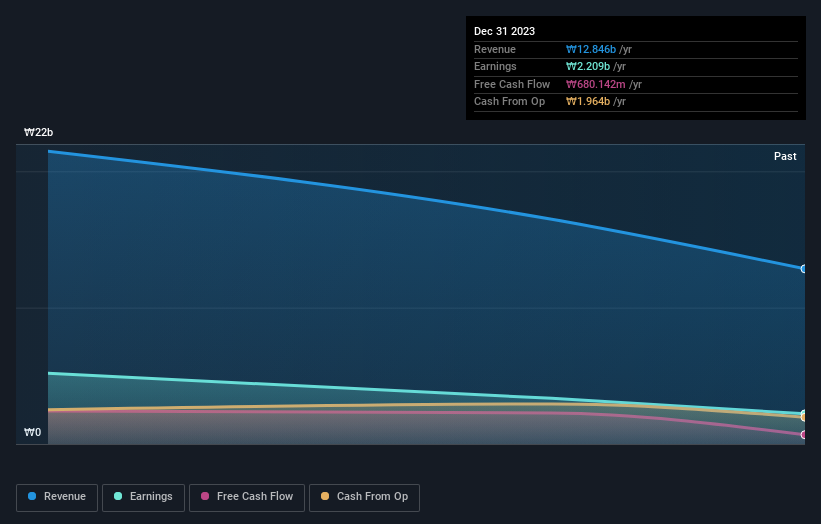Stock Analysis
- South Korea
- /
- Semiconductors
- /
- KOSDAQ:A396470
Following recent decline, WOT. Co., Ltd's (KOSDAQ:396470) top shareholder CEO Seung-Bae Park sees holdings value drop by 16%

Key Insights
- Insiders appear to have a vested interest in WOT's growth, as seen by their sizeable ownership
- The largest shareholder of the company is Seung-Bae Park with a 55% stake
- Using data from company's past performance alongside ownership research, one can better assess the future performance of a company
A look at the shareholders of WOT. Co., Ltd (KOSDAQ:396470) can tell us which group is most powerful. With 65% stake, individual insiders possess the maximum shares in the company. Put another way, the group faces the maximum upside potential (or downside risk).
As a result, insiders as a group endured the highest losses after market cap fell by ₩31b.
Let's delve deeper into each type of owner of WOT, beginning with the chart below.
Check out our latest analysis for WOT

What Does The Lack Of Institutional Ownership Tell Us About WOT?
We don't tend to see institutional investors holding stock of companies that are very risky, thinly traded, or very small. Though we do sometimes see large companies without institutions on the register, it's not particularly common.
There could be various reasons why no institutions own shares in a company. Typically, small, newly listed companies don't attract much attention from fund managers, because it would not be possible for large fund managers to build a meaningful position in the company. On the other hand, it's always possible that professional investors are avoiding a company because they don't think it's the best place for their money. WOT's earnings and revenue track record (below) may not be compelling to institutional investors -- or they simply might not have looked at the business closely.

Hedge funds don't have many shares in WOT. With a 55% stake, CEO Seung-Bae Park is the largest shareholder. With such a huge stake, we infer that they have significant control of the future of the company. It's usually considered a good sign when insiders own a significant number of shares in the company, and in this case, we're glad to see a company insider with such skin in the game. For context, the second largest shareholder holds about 4.8% of the shares outstanding, followed by an ownership of 4.5% by the third-largest shareholder.
While studying institutional ownership for a company can add value to your research, it is also a good practice to research analyst recommendations to get a deeper understand of a stock's expected performance. Our information suggests that there isn't any analyst coverage of the stock, so it is probably little known.
Insider Ownership Of WOT
While the precise definition of an insider can be subjective, almost everyone considers board members to be insiders. Management ultimately answers to the board. However, it is not uncommon for managers to be executive board members, especially if they are a founder or the CEO.
Insider ownership is positive when it signals leadership are thinking like the true owners of the company. However, high insider ownership can also give immense power to a small group within the company. This can be negative in some circumstances.
It seems that insiders own more than half the WOT. Co., Ltd stock. This gives them a lot of power. Given it has a market cap of ₩163b, that means they have ₩105b worth of shares. Most would be pleased to see the board is investing alongside them. You may wish todiscover (for free) if they have been buying or selling.
General Public Ownership
With a 35% ownership, the general public, mostly comprising of individual investors, have some degree of sway over WOT. This size of ownership, while considerable, may not be enough to change company policy if the decision is not in sync with other large shareholders.
Next Steps:
It's always worth thinking about the different groups who own shares in a company. But to understand WOT better, we need to consider many other factors. Be aware that WOT is showing 3 warning signs in our investment analysis , and 2 of those are a bit unpleasant...
Of course, you might find a fantastic investment by looking elsewhere. So take a peek at this free list of interesting companies.
NB: Figures in this article are calculated using data from the last twelve months, which refer to the 12-month period ending on the last date of the month the financial statement is dated. This may not be consistent with full year annual report figures.
Valuation is complex, but we're helping make it simple.
Find out whether WOT is potentially over or undervalued by checking out our comprehensive analysis, which includes fair value estimates, risks and warnings, dividends, insider transactions and financial health.
View the Free AnalysisHave feedback on this article? Concerned about the content? Get in touch with us directly. Alternatively, email editorial-team (at) simplywallst.com.
This article by Simply Wall St is general in nature. We provide commentary based on historical data and analyst forecasts only using an unbiased methodology and our articles are not intended to be financial advice. It does not constitute a recommendation to buy or sell any stock, and does not take account of your objectives, or your financial situation. We aim to bring you long-term focused analysis driven by fundamental data. Note that our analysis may not factor in the latest price-sensitive company announcements or qualitative material. Simply Wall St has no position in any stocks mentioned.
About KOSDAQ:A396470
WOT
WOT. Co., Ltd manufactures and sells temperature and humidity control equipment for the semiconductor production process in South Korea.
Flawless balance sheet with weak fundamentals.

